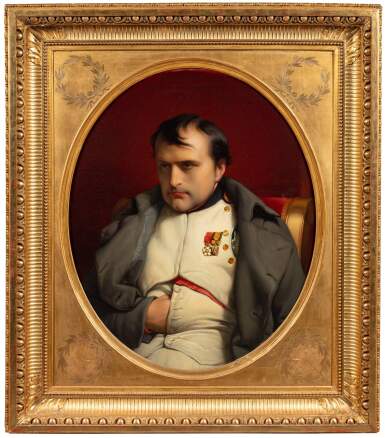
Paul Delaroche
Napoleon I at Fontainebleau, 31 March 1814
Auction Closed
June 25, 05:03 PM GMT
Estimate
150,000 - 250,000 EUR
Lot Details
Description
Paul Delaroche
Paris 1797 - 1856
Napoleon I at Fontainebleau, 31 March 1814
Oil on canvas, probably in its original frame
Signed and dated center right Paul DelaRoche 1848
81,4 x 65 cm ; 32 by 25⅝ in.
We are grateful to Dr. Stephen Bann for having confirmed the authenticity of the work after first-hand inspection.
With Jean-François Heim;
Where acquired by the present owner, in 2004.
Napoleon: An Intimate Portrait. A travelling exhibition from the Russell Etling Company featuring the Collection of Pierre-Jean Chalençon, Catalogue by Pierre-Jean Chalençon, Brett Topping and Russell Hull Etling, Russell Etling Company, 2005-2011, pp. 80-81.
Napoléon, l'Empereur sous la verrière du Grand Palais : La collection Pierre-Jean Chalençon, cat. exh. Grand Palais, Paris 2018, pp. 22-23.
This unexpected and surprising image shows a vulnerable Emperor stripped of his arrogance and his mythical quality. The oval format and the tight framing of the composition focus attention on his sombre, embittered features. In this portrait of great psychological impact, the Emperor has reached the end of his reign, but does not seem ready to accept it, as is implied by the tension in his face and his tight-lipped expression. He is wearing his decorations and has slipped his right hand into his waistcoat, a typical gesture which is now associated with the figure of Napoleon as Emperor and conqueror.
This is an autograph replica, bust-length, of the large full-length portrait Delaroche painted in 1840. Napoleon’s determination, evident in the bust version, is tempered by many symbolic details underlining the Emperor’s solitude and despondency, sitting or rather slumped on a chair, with his right arm hanging over its back. His wretchedness is visible in his dejected pose, his chest stripped of decorations, his hat thrown on the floor and his sword abandoned on a small side table. In the background, a red curtain seems to be drawn over the Empire’s splendour.
This highly complex painting plays on two registers. The first relates to the events of the moment: Napoleon taking refuge in Fontainebleau as the Russian troops enter Paris, knowing his abdication is unavoidable but still wanting to believe in his lucky star. The second concerns historical memory, reflecting Delaroche’s familiarity with the events of the Hundred Days, followed by the Emperor’s fall and exile to St Helena.
This very personal interpretation of Napoleonic iconography tallied with Delaroche’s anxious and melancholy temperament: ‘It is as though this painter, illustrious yet subject to depression, was increasingly identifying with the Emperor, not in his hours of glory but in his moments of defeat and disenchantment’ (see S. Bann in the catalogue of the exhibition Paul Delaroche - Un peintre dans l’histoire, Musée des Beaux-Arts, Nantes; pavilion of the Musée Fabre, Montpellier, October 1999–April 2000, pp. 58–60; our translation). For comparison, it is worth mentioning, among the rich corpus of works Delaroche produced on the Napoleonic theme, General Bonaparte Crossing the Alps, in which the future hero of the Italian Campaign is simply dressed in a grey coat, somewhat uneasily riding a humble mule (Musée du Louvre). This scene, as close as possible to the reality as imagined by Delaroche, could not have been further from the idealized image of the young, self-assured conqueror, prancing on his spirited steed, portrayed in David’s masterpiece (see lot 3).
This striking and romantic depiction of the fall of the man who had been the most powerful and feared in the world is one of the most famous and representative images of the Napoleon myth that fascinated and inspired so many artists, in France and elsewhere, throughout the nineteenth century. ‘The painting established […] the image of an antihero and helped to create the legend of the Fallen Eagle’ (see I. Mayer Michallon, in exh. cat. 1999–2000, op. cit., p. 208; our translation). The power of this portrayal accounted for the painting’s enormous popularity, as evidenced by the many versions Delaroche himself painted in different sizes, several of which are listed in Stephen Bann’s monograph (see S. Bann, Paul Delaroche, History Painted, London, 1997), including one in the Musée de l’Armée, Paris. The painting was also widely disseminated through engraving. This popularity continued into the twentieth century with film makers.
